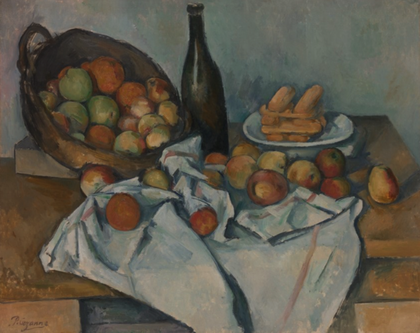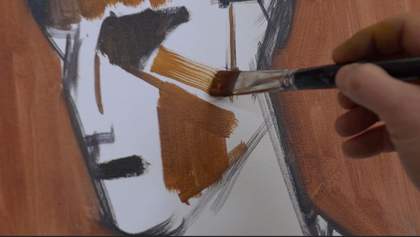Largely unappreciated in his lifetime, his work is now admired across the world. Here are five things you may not know about this extraordinary painter ahead of our Tate Modern exhibition:
1. Artists from Monet to Picasso collected Cezanne’s art
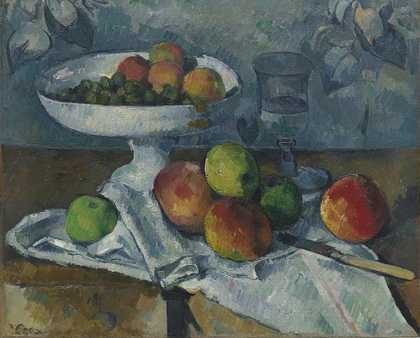
Paul Cezanne Still Life with Fruit 1879-80 The Museum of Modern Art, New York, gift of Mr and Mrs David Rockefeller, 1991, 69.1991 . Digital image, The Museum of Modern Art, New York/Scala, Florence
Until the final years of his life, Cezanne did not have much mainstream success as an artist. However, fellow artists were the first to recognise his unique, seemingly ‘unsophisticated’ (according to critics at the time) painting technique.
Cezanne’s work was heavily collected during his lifetime by Claude Monet (who owned 15 Cezannes, hanging three in his bedroom), Pierre-Auguste Renoir, Edgar Degas, Édouard Manet, Camille Pissarro (who owned at least 31 works), Henri Matisse and Pablo Picasso. Paul Gauguin even used to take one of his favourite Cezannes to a nearby restaurant to show off the painting.

Paul Cezanne Bathers (Les Grandes Baigneuses) c. 1894 - 1905 The National Gallery, London, purchased with a special grant and the aid of the Max Rayne Foundation, 1964
2. He initially thought of himself as a poet rather than a painter
Cezanne loved literature and even wrote his own poetry. As a teenager, he saw himself first as a poet – he began painting on the side when he was in school.
With his close childhood friend, novelist Émile Zola (known together as ‘the inseparables’), he would spend time after school bathing in his local river, writing poems and reading, ‘with books in our pockets...our loves, in those days were above all, the poets.’
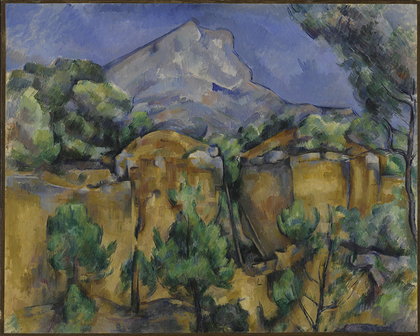
Paul Cezanne Mont Sainte-Victoire Seen from the Bibémus Quarry c. 1895-99 The Baltimore Museum of Art: The Cone Collection, formed by Dr. Claribel Cone and Miss Etta Cone of Baltimore, Maryland, BMA 1950
3. His home of Aix hugely influenced his work
Cezanne loved his hometown of Aix-en-Provence. He said the hills above Aix were the place of his happiest memories. Unlike many artists of his day, he wasn’t tempted to permanently stay in Paris. Instead, he spent his time between Paris and Aix, and primarily stayed in the south after 1886.
It was in and around these hills that he would paint local landscapes and landmarks such as the Bibémus quarry, Château Noir and Mont Sainte-Victoire – he painted this mountain more than 80 times. He was still painting the countryside around Aix at the time of his death in 1906.
‘In us there’s been no decline in the vibration of sensations emitted by this fine sun of Provence, these horizons, these landscapes, these uncreated lines that leave so many deep impressions within us.’
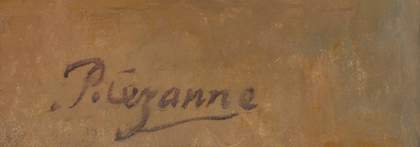
Paul Cezanne The Basket of Apples c. 1893 The Art Institute of Chicago. Helen Birch Bartlett Memorial Collection, 1926 (detail)
4. Cezanne’s name has a traditional spelling
The painter never signed his name with an accent on the ‘e’, these weren’t used in the local dialect of Provence where the artist is from. Instead, the accent only started to appear in texts after he arrived in Paris in the 1860s, when people often mispronounced his name.
Tate’s decision to use the name ‘Cezanne’ without the accent follows a campaign by Philippe Cezanne, the artist’s great-grandson and honorary president of the Cezanne society, to revert his name to its original spelling.

Paul Cezanne Portrait of the Artist with a Pink Background c. 1875 Musée d'Orsay, Paris, donation of M. Philippe Meyer, 2000
5. He died doing what he loved
Just a few days before his death, Cezanne wrote, ‘I have vowed to die painting,’ which is essentially what he did. One day, while he was painting outside during a storm, he collapsed.
He was out in the rain unconscious for hours before he was found by a laundry cart. A week later at 67, he passed away, possibly from pneumonia from his time in the storm.
The EY exhibition Cezanne is at Tate Modern 5 October 2022 – 23 March 2023.


